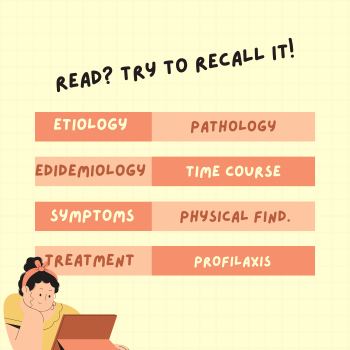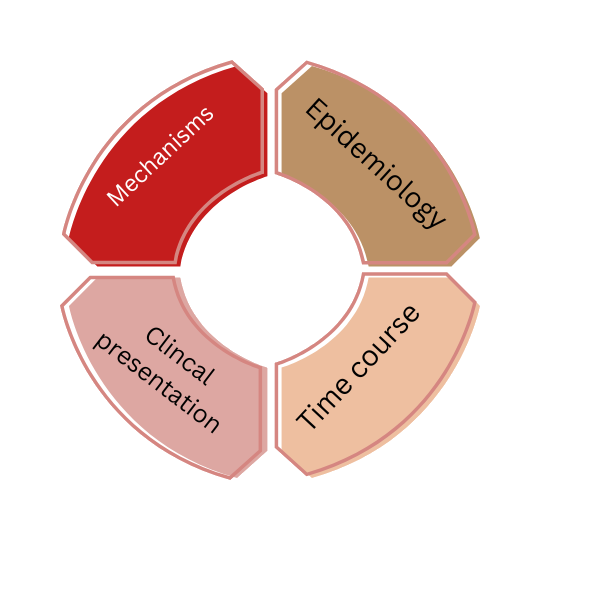Illness script
We have to compare these with our book knowledge and come up with a further diagnosis and treatment plan.
But this is where the ambush can lurk.
Medical textbooks are organized in such a way that each disease exists as an abstraction that lives its own ideal life.
Remember how disease information is usually presented there.
It is usually so-called horizontal reading.
Etiology → Epidemiology → Pathophysiology → Clinical Features → Diff ds → ect

Over time, the amount of reading will increase tremendously, and human memory is unfortunately limited. Under stressful clinical conditions we will have to scramble to remember what a particular patients symptoms look like.
That's how the concepts of illness script and patient script have been created.

Illness script is the result of the processing of our book knowledge gained through horizontal reading.
As you gain clinical experience, new features and benefits will be added to the illness script.
But for now, we are at the very beginning of the journey. Let's try to filter the information so that we can extract only what is relevant to the four sections: Epidemiology, Time Course, Classic Clinical Features, Pathophysiology.
- Age
- Gender
- Environmental factors
- Living conditions
- Travelling
- Hobby
- Hyperacute (hours)
- Acute (days)
- Subactute (weeks)
- Chronic
- Constant
- Episodic
-
How long has it been going on and what happens in between?
-
Patern of symptoms
What are the classic signs or symptoms? What might you find on history and physical exam?
Anatomy, physiology, immunological,biochemical pathways,genetics, ect
What are the known environmental contributors?
Microbiology,Toxins,Pharmacology
Now it's time to answer the following question:
- Key or Differentiating features allow one to distinguish between diseases that may present with the same syndrome.
Key feature of the diagnostic triad should be found only in one of the conditions and not in the other.
Differentiating features are common to only two of the diagnosis - Must-have features Without it, the disease can't be diagnosed.
-
Rejecting Feature. If present, the diagnosis can't be made.
For example, active reflexes are incompatible with a diagnosis of Guillian Barre Syndrome.
Let's look at the following diagram.
At the beginning of contrast learning let's start with three diseases with similar presentation. Two will be too little, more then three - too difficult. Expending the list begins to be hard to identify key features.
Organizing syndromes can be clinical or lab based.Just to remind you that we are talking about classic signs and symptoms.
- Vomiting signed as ⁕ is located at the center of the diagram. It's common in all three diseases. So it's not a differentiating feature.
- Meningitis and intracerebral bleed may present with confusion and/or neck stiffness. This symptom is not present in migraine. This feature is common to only two of the diagnosis so we can called it differentiating.
- Key feature of meningitis will be fever
- Rejecting feature in meningitis will be normal spinal fluid (although there are some exceptions)
Patient with acute onset of headache
List of our diff ds may consist of migraine, meningitis and intracranial bleeding. Let's try to compare theses diseases using terms above.

The following example illustrates contrast approach as a table. Let's compare each set of elements of the illness-scripts which can help us to build a framework to store information for the future. Again we can use key features that should be a core element of these disease illness-scripts.
-
Massive hemoptysis is common in Goodpasture's syndome but not for other diseases in the triad. Let's mark it as *** in the column Symptoms
-
Strong smoking history is a key feature of epidemology in many forms of Lung cancer but it's not a common feature of Goodpasture's syndrome or Granulomatosis with polyangitis So let's mark it as a Key feature in the table column Epidemiology.
Patient with hemoptysis
Lets identify three diseases that might present with this syndrome. For example: Lung cancer, Goodpasture syndrome and Granulomatosis with polyangitis for the sake of illustration.
Key features-
Differentiating feature in this triad is hematuria
-
Goodpasture's Sd and Granulomatosis with polyangitis present with glomerulonephritis but not Lung cancer. Let's put it as a differentiating feature in the column "Diff ds tests"
| Disease | Epidemiology | Symptoms | Diff dx tests |
|---|---|---|---|
| Lung cancer | Smoking*** | No hematuria | |
| Goodpasture's syndrome | Hemoptysis*** | Hematuria + | |
| Granulomatosis with polyangitis | Hematuria + |
 What advantages does this approach have ?
What advantages does this approach have ?
 What are the disadvantages of this approach ?
What are the disadvantages of this approach ?